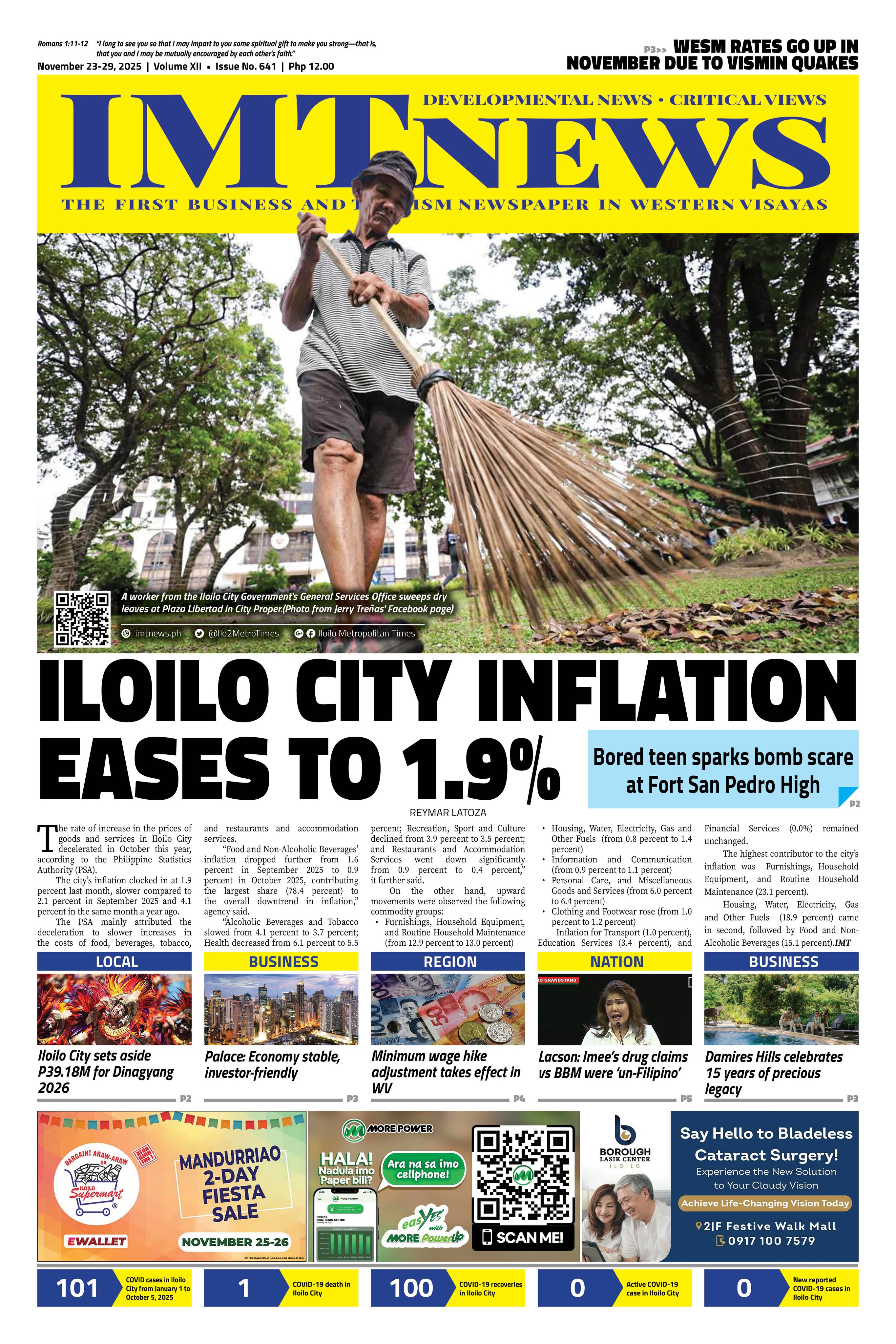There are places in every city that do not just stand—they stay. Not because they are made of concrete or carry grand signage, but because they live in people’s stories. For many Ilonggos, 78-year-old Socorro Drug Store was never just a pharmacy—it was a familiar face at the busy corner of Plazoleta Gay. Come July 15, 2025, as it quietly shuts its doors, it will not feel like just another business closing, but like a beloved chapter gently folding in the hearts of generations who grew up saying, “sa lugar lang sa Socorro,” every time their jeep slowed near Calle Real.
The story of Socorro is rooted in a postwar dream. Founded in 1947 by Gloria Jesena Lorca Tirol, it was named after her mother, Socorro Jesena Lorca, and later run with her husband, Roberto Hontiveros Tirol. It began on Iznart Street, facing the Iloilo Central Market, and over time expanded into branches at J.M. Basa, Ledesma, and Rizal Streets. All but one—the Plazoleta Gay branch—eventually bowed out, like elders quietly giving space to the next generation. That final survivor, the one etched into the Ilonggo’s mental map, is now also taking its last bow.
The closure was confirmed by Jake Tirol Cocjin, grandson of Roberto and Gloria, and son of Ruth Tirol Jarantilla. On social media, he thanked loyal employees and hinted at a new chapter: a possible pharmacy in Pavia under the name “Mama Ruth’s Pharmacy by Socorro Drug.” Just above the “S” logo, a quiet “For Rent” sign now hangs—a small marker with a heavy weight. Socorro was never just a store. It was a compass in downtown life—a suki stop, a waiting place, a haven after exams, a pharmacy that spoke Kinaray-a back with a knowing nod. The goodbye may be logistical, but the loss is deeply personal.
Socorro was where the sidewalk breathed—vendors with fried peanuts and balut, balinghoy and suman in leaves, fishballs and kwek kwek crackling in oil, smorgasbord of candies and fresh fruits, plastic-packed lutong-bahay viands, and socks resting from makeshift racks. Alongside them sat washing sachets, cards, toys, trinkets, RTWs, clothespin, ukay finds, and even mobile loads—everyday things you did not know you needed. They were not just sellers—they were part of the place. They were familiar, steady, and never in the way. They established a tranquil cadence within a city that was gradually accelerating its pace.
More than a chain, Socorro became a rhythm in the life of downtown Iloilo. It stood firm through fires, floods, inflation, and the rise of drugstore giants like Mercury, Watsons, South Star, and Rose. Back then, it was the only place where Lola got her liniment and Tito his maintenance meds—no scanners, no apps, just handwritten labels and amiable pharmacists who knew your name and asked how the grandkids were.
The charm of Socorro lay not in its scale, but in its sincerity. It offered what is vanishing in today’s convenience-driven world: tiwala, salig. Trust. The kind where a suki could say, “Bayaran ko lang buwas, Manang,” and that was enough. It was where people paused—not just for medicine, but to get directions, wait out the rain or runoff, or reconnect with someone from the past. When the rest of the city began to digitize and scale up, Socorro stayed human. It kept downtown Iloilo alive in the way that mattered most—not perfectly, but personally.
But change knocks, often quietly. Sometimes, it comes in the form of a landlord or city raising rent or taxes. Sometimes, it arrives as a grandson realizing the world his mother built is no longer viable in today’s margins. And sometimes, it is simply the passing of time. According to socio-cultural studies (Smith, 2021; Velasco, 2019), when life pulls the next generations in new directions, even the most treasured family ventures can struggle to keep going. Priorities shift, the world speeds up, and newer ways of working begin to take over. Socorro’s story is a quiet kind of heartbreak—familiar, perhaps, but deeply personal to those who grew up with its warmth.
Its impending closure has stirred both sorrow and reflection. Some shared stories of childhood waffle snacks sold at its doorstep. Others recalled how Socorro was the meet-up point for dates, gigs, or before heading to Marymart, Shoemart, Robinsons, or Marymart. One post read: “My grandmother used to say, ‘If you ever get lost, wait at Socorro.’” That was the kind of anchor it was—an alternative kilometer zero of sorts. A reference point in both geography and life.
What does it mean when landmarks like Socorro disappear? It means directions will shift, yes—but more than that, it marks a deeper disconnection from place. Iloilo may be blooming with buildings, bridges, boulevards, and business parks, but even the most modern city can quietly lose parts of its soul. As high-rises fill spaces like Iloilo Business Park and chain stores edge out old corners, places like Socorro fade—unless we choose to remember.
The city’s revival of Calle Real, from the NCCA-funded repainting of Spanish-era facades to the Elizalde Building’s rebirth as the Museum of Philippine Economic History, shows that growth and memory can go hand in hand. Even the messy overhead wires were placed underground, letting the street’s charm speak again. But revitalizing Calle Real cannot rest on cosmetic efforts alone. Its survival depends on deeper reforms—economic, infrastructural, and socio-cultural—that breathe life back into foot traffic, commerce, and community presence.
Hence, we must learn to see heritage not just in grand facades or Spanish columns and American cornices, but in places like Socorro—humble, familiar, and deeply felt. The 2021 UN World Heritage and Tourism Report reminds us: what touches people most are places rooted in community, not just architecture. Preserving them should be about honoring stories, not just saving structures or chasing visual appeal. It should include the preservation of experience, of language, of narratives, of memory. In a city like Iloilo, where “sa lugar lang sa Socorro” is more than a command—it is a ritual—we owe it to ourselves to ask: what will replace that space in our shared vocabulary, our shared collective consciousness?
This is not to resist progress. Iloilo needs infrastructure, jobs, and innovation. All around the city, plus the neighboring Pavia, Oton, and Leganes towns, buildings keep rising and new shops keep opening—quiet signs that the Metro Iloilo is moving forward, step by step. You do not need a headline to see it; the change speaks for itself in concrete, steel, panel, and the hum of everyday life. Yet amid the glass walls and wide roads, there are touches that remind us we have not left our roots behind. Take the Iloilo Convention Center—its design, shaped like the sails of our old paraws, shows that growth does not have to mean forgetting where we came from. But the balance lies in intentionality. Who decides what stays and what goes? What voices are heard in that process? As anthropologist and cultural historian Fernando “Butch” Nakpil Zialcita notes, development must be dialogical—it must listen, not just impose.
As teachers, parents, workers, entrepreneurs, and citizens, we must carry these stories and tell them not just with sadness, but with purpose. Socorro’s closing is not just an end—it is a reminder. That the way we build, preserve, and narrate our spaces tells us who we are and what we value. If “progress” makes no space for memory, then it risks becoming hollow. But if it draws from what places like Socorro stood for—trust, kindness, reliability, community—then maybe, just maybe, we can grow without forgetting where we came from.
Soon, Ruthcelmar Drugstore on Ledesma Street will take the mantle as the city’s oldest operating pharmacy. Let us hope it continues. Let us hope, too, that the iconic triangular corner where Socorro stood remains a landmark—not because of the owner, business, or building that replaces it, but because of the stories that stay. Maybe someday a child will ask why that place is called “Socorro,” and someone will answer with a story that begins, “Dira kami permi ga kitaay sang una…”
Because in the end, Socorro was never just a place to buy medicine. It was where people slowed down, where paths crossed, and where the quiet heartbeat of the city echoed for 78 years.
Thank you, Socorro.
Doc H fondly describes himself as a “student of and for life” who, like many others, aspires to a life-giving and why-driven world grounded in social justice and the pursuit of happiness. His views do not necessarily reflect those of the institutions he is employed or connected with.







